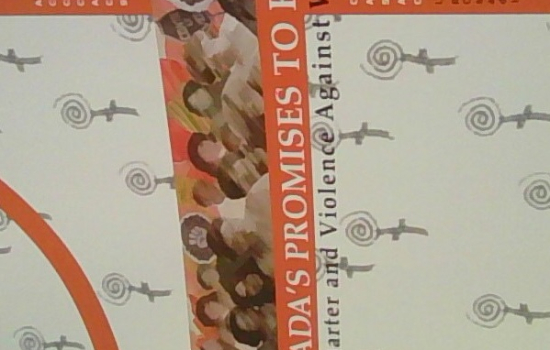
Accueil > Centre de documentation > Féminisme/sociologie > Canada’s Promises to Keep: the Charter and Violence Against Women
Canada’s Promises to Keep: the Charter and Violence Against Women
Féminisme/sociologie Retour à toutes les catégories

Canada’s Promises to Keep: the Charter and Violence Against Women
Executive Summary
By Lee Lakeman, © 2003
Canadian Association of Sexual Assault Centres (CASAC en anglais)
Association canadienne des centres contre les agressions à caractère sexuel (ACCCACS)
This inquiry considers how to express more fully what it means to the Canadian Association of Sexual Assault Centres (CASAC) to seek a better and feminist future for women in Canada. Our current reality of a system of violent repression of women’s rights persists. We seek a future in which it will be a rare occasion when a man abuses a woman and in that future the response will be swift and just. We look to a future where women live in autonomy, peace, and freedom, without the hideous enforcer phenomenon of violence against women.
CASAC has always been concerned with the low conviction rates and high attrition rates in cases of violence against women. In the CASAC LINKS project we focused our inquiry on the questions: How does the system prevent convictions of violence against women? We asked how do the policies procedures and practices of the justice system impact on the low conviction rates of violence against women and what is the relationship of these impacts to women’s inequality. We looked for and found one hundred criminally assaulted women who would tell their stories of using the Justice system in eleven locations across Canada. And we grouped their answers in relation to:
· Emergency response
· Police investigation
· Crown attorney decisions
· Court proceedings
· Sentencing
By law each of 92 cases women brought to the system merited conviction on at least one charge. The justice system convicted men in only 34 of women’s cases.
We asked for the justice system’s documents regarding policy and procedure of those justice functions at the same sites. We examined those documents for consistency with understandings of the Charter of Rights and Freedoms. That data was collected and analyzed across Canada at both the eleven sites and further collected and analyzed nationally. It was compared and added to the international positions Canada has promoted and the current national situation as seen by our member centres and as understood by the women who engaged the justice system at those sites. In combination we expected to see some of the nature of and reasons for low conviction rates and high attrition rates in these and other cases of violence against women. And we did.
We found that the Charter obligations to the women of Canada are ignored by those responsible for emergency services, police intervention, and those prosecuting cases. The promise to women in the Charter of Rights and Freedoms is broken when it comes to women who complain of violence against women.
We found that women calling the police expect that they are calling on their rights to equality and on Canada’s obligation to protect those rights. We found that women around the world are complaining of the same horrors of violence against women and poverty. And most national groups of women complain of their government’s response. In coalition with other Canada wide groups and in conjunction with women’s groups around the world women are saying that we know we have a right to be free of violence against women, as well as poverty, and that we are developing an international agenda, mechanisms, and a movement to address those concerns. We have come together to complain of that violence and poverty through the World March of Women to national governments at International Social Forums, at the World Bank, and World Trade Organization (WTO) processes, and at the United Nations.
We read the Charter of Rights and Freedoms together with international documents outlining human rights agreements of states in the United Nations: each document being designed to inform the other. The United Nations, Convention on the Elimination of All Forms of Discrimination Against Women (CEDAW) committee, criticized Canada in January 2003. After our report to them they criticized Canada’s failures to over see with economic mechanisms that all levels of government comply with international agreements that Canada signs. They criticized the failure to support substantive equality, including the provision of social welfare, funding for equality test cases, Canada’s treatment of aboriginal women, women’s poverty, immigration policy, the treatment of women trafficked. The United Nations made a special point of urging the Canadian government to “step up its efforts to combat violence against women and girls and increase its funding for women’s crisis services and shelters in order to address the needs of women victims of violence under all governments.”
We operated with some hope of improving the treatment of women and children.
In this project we were connecting the restructuring of Canada with respect to social programs, the function and effect of feminist women’s anti-violence centres, the women who use them, and the Charter of Rights and Freedoms. That new Charter in the constitution promises all women in Canadian equality under the law and protection of the law. We were connecting that promise to the lived experience of women who complain to the criminal justice system after an incident of sexist violence. For five years we participated in local national and international meetings coalitions and actions. We saw that globalization is changing the Canadian state and changing violence against women. We saw the promised indivisibility of rights and, therefore, assessed the impact of other inseparable issues of women’s equality. We saw among other things increased trafficking of women, the loss of welfare to women, and shifts in the criminal justice system that effectively decriminalize violence against women. We found that the changes from Canada Assistance Program (CAP) to the Canada Health and Social Transfer (CHST) and the Social Union Framework Agreement (SUFA) are changing federal provincial relations. Those changes must be adjusted to prevent further undermining of the promise of equality and freedom from violence made to Canadian women.
We hoped to encourage change along the way. We had already made public 99 Federal Steps Toward an End to Violence Against Women as a program that could reduce violence against women. Throughout that document, and this one, as well as across the five-year span, we recommended guidelines for policy changes on issues of criminalizing violence and developing equity. We hoped we might improve the policy development of police and crowns at least in relation to wife assault, sexual assault, criminal harassment, peace bonds, and sentencing. We knew we would be of assistance to women beaten and raped including, within the family, as well as those at risk on the job, and those driven into prostitution. But at the end of this five-year project we find the situation is worse for women reporting violence for criminalization.
The project was also conceived to benefit rape crisis centres, many of which have existed for years in their communities with too little or no federal government funding, in spite of the start up funds of the 1970s, which identified these centres as vital to the advancement of the equality of women. That usefulness and the demand for the centres is evident in the numbers of women who call every year, the numbers who want to be involved with the independent women’s movement, and who want and need information about the law and their rights under the Canadian Charter of Rights and Freedoms. We found that the involvement of independent feminist advocates in a legal case increases the likelihood of conviction. At the end of this five-year project women’s centres against rape and wife assault have less access to federal dollars than five years ago. CASAC LINKS has regenerated a commitment from Canadian feminists to insist on the political and economic support necessary to sustain women’s centres, transition houses, and rape crisis centres, as the best tools women have to decrease their isolation, and vulnerability to violence against women, and to increase the convictions that criminalize that violence.
Lien(s) intéressant(s)
 |
Heures d’ouverture Sans rendez-vous : Lundi au vendredi : 8 h 30 - 12 h et 13 h - 16 h 30 Avec rendez-vous : Lundi au vendredi : 8 h 30 - 16 h 30 |
|
| C.P. 6177 Baie-Comeau (Québec) G5C 0B7 |
418-589-1714 1-800-563-0443 calacs@lumiereboreale.qc.ca |
Urgences 24/7 : 1-888-933-9007
Merci infiniment aux artistes Connie F. Stone, Denis Beausoleil, Joseph Simard, Michel Bélanger, Jean-Charles Tremblay et Sébastien St-Jean.
En faisant don d’eux-mêmes, ils nous ont permis d’aller plus loin dans notre mission et d’ainsi, vous offrir un espace accueillant.

